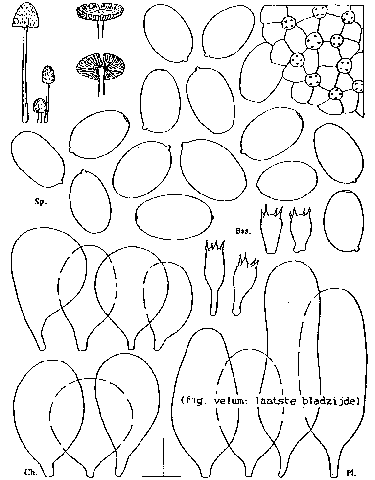Macroscopic features |
Pileus 6 x 4 mm when still closed, expanded 8-16 mm, rounded conical, first entirely covered with white, felty veil, at centre often sepia-coloured and persistent there, breaking up in small, hairy-floccose scales. Lamellae crowded, free, first white, later blackish brown. Stipe up to 30 x 0,5-1 mm, whitish, minutely fibrillose-floccose, later glabrous; base slightly bulbous. |
Microscopic features |
Spores [100,4,2] 8.5-13.7 x 6.0-9.1 µm, ellipsoid or ovoid, rounded at apex, dark red-brown, with central, c. 1.5 µm wide germ pore; Q = 1.30-1.75, gem. Q = 1.50-1.60; av. L = 10.3-12.4, av. B = 6.8-7.9 µm. Basidia 14-28 x 9-10 µm, 4-spored, surrounded by 4-6 pseudoparaphyses. Pleurocystidia 60-90 x 25-28 µm, ellipsoid, (sub)cylindrical. Cheilocystidia 35-55 x 20-32 µm, ellipsoid or (sub)globose. Elements of veil thick-walled, 3-9 µm wide, diverticulate and strongly, multiple-branched with long, thick-walled terminal elements, ascending from the pileipellis; walls up to 1.5(-2.5) µm thick. Clamp-connections present. |
Habitat & distribution |
In small groups on dung of deer and elephant. Very rare. Europe, Africa. Not known from the Netherlands. |
Remarks |
Microscopically C. vermiculifer can easily be recognized by the brown, thick-walled terminal elements of the veil in combination with the large spores and the habitat on dung. |

[Copyright © by ]